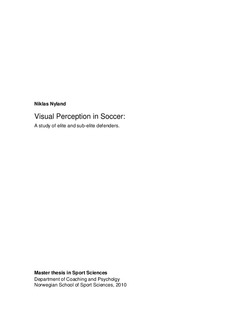Visual perception in soccer: a study of elite and sub-elite defenders.
Master thesis
Permanent lenke
http://hdl.handle.net/11250/171663Utgivelsesdato
2010Metadata
Vis full innførselSamlinger
Sammendrag
The general purpose of this study was to examine how soccer defenders explore the envi-ronment for and use the information to deny opponents goals from crosses into the penalty area. A specific aim was to determine which variables differentiated between elite and sub-elite players. An ecological approach was used as conceptual framework. Participants were at the Premier League level - classified as elite (n = 13, m = 28.15 yrs, SD = 3.82) and at the Reserve League and Academy League level - classified as sub-elite (n = 11, m = 18.3 yrs, SD = 1.40). All participants were filmed in at least one game (six were filmed in two game). A high zoom camera recorded and focused solely upon a single player and general game events were obtained from professional camera recordings (obtained from the clubs) using regular zoom. These two videos were edited and synchronized into a split-screen video.
Results indicate that players in the elite group are more perceptually and functionally active than players in the sub-elite group prior to a cross, by exploring more frequently and posi-tioning themselves more with a back-towards-goal posture allowing them to visually per-ceive more of the actions of the surrounding forwards. However, it was not demonstrated any functional relationship between exportation and performance related to this defensive situation. Further, constraints such as the player‟s posture, type of defence, distance be-tween the crosser and defender, and involvement showed some differences between the levels and may affect exploration.
Keywords: Visual perception; Ecological approach; Soccer; defence; Exploratory activ-ity
Beskrivelse
Masteroppgave - Norges idrettshøgskole, 2010
